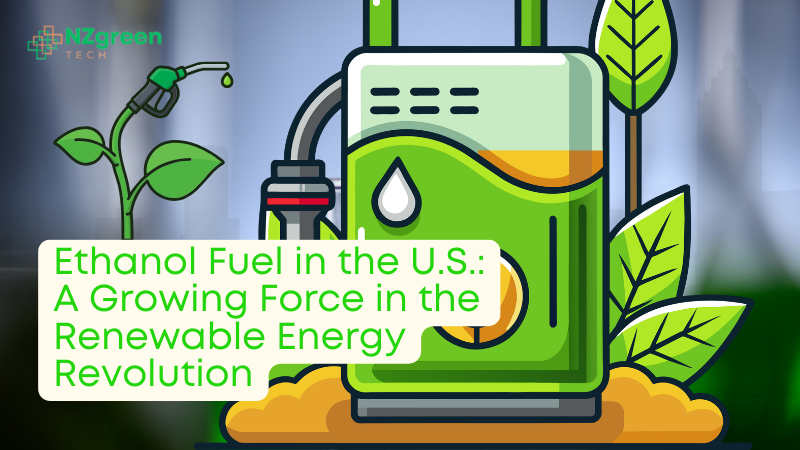As the world shifts toward sustainable energy solutions, ethanol fuel has emerged as a critical player in the U.S. fuel landscape. With increasing environmental concerns and governmental mandates, ethanol is becoming a mainstream alternative to conventional gasoline. The U.S. ethanol fuel market is not only essential for reducing greenhouse gas emissions but also for meeting renewable fuel standards that have transformed the way the country approaches its energy consumption.
This blog delves into the future of ethanol fuel in the U.S., exploring its growth trajectory, key market drivers, and what lies ahead for this important renewable energy source.
Growth Surge in U.S. Ethanol Fuel Market
The U.S. ethanol fuel market, valued at USD 27.6 billion in 2024, is set to reach USD 42.1 billion by 2032. This impressive growth represents a compound annual growth rate (CAGR) of 5.5% from 2025 to 2032. What’s driving this growth? A combination of factors, including the government’s renewable fuel standards, the growing adoption of higher ethanol blends like E15, and a heightened demand for cleaner fuel options that reduce environmental impact.
A significant factor contributing to ethanol’s growth is the Renewable Fuel Standards (RFS) program. This federal mandate requires the blending of ethanol into transportation fuels to lower dependence on foreign oil and reduce emissions. Additionally, various state-level policies, such as California’s Low Carbon Fuel Standard (LCFS), promote the use of ethanol, especially in regions with stringent emissions reduction goals. These regulatory frameworks help establish a stable market, ensuring ethanol producers continue to thrive.
The Midwestern Advantage
Geographically, the Midwest holds the largest share in the U.S. ethanol fuel market and is also the fastest-growing region. Known as the heart of U.S. corn production, this region’s ability to supply large volumes of feedstock like corn, which is the primary ethanol source, provides a substantial advantage. As the U.S. leads the world in corn production—producing over 389 million tonnes in 2023—this accessibility to raw materials supports a robust ethanol industry.
In this landscape, corn-based ethanol remains the dominant feedstock, accounting for 55% of the market in 2024. However, the industry is evolving, with cellulosic biomass—a feedstock derived from agricultural residues and grasses—emerging as the fastest-growing category. This growth is propelled by innovations in biofuel production and government support for sustainable energy solutions.
Ethanol’s Expanding Applications
While transportation fuel remains the largest application category for ethanol, the versatility of this renewable resource is expanding. The rise of higher ethanol blends such as E15 (15% ethanol and 85% gasoline) is a key trend. E15 is cleaner-burning, has a higher octane rating, and provides better fuel economy, which makes it an attractive alternative to conventional gasoline. With approximately 3,000 gas stations in 31 states now offering E15, the availability and adoption of this ethanol blend are steadily increasing.
Beyond transportation, ethanol is also making waves in the aviation sector. The U.S. Department of Energy (DoE) has highlighted ethanol’s role in producing Sustainable Aviation Fuel (SAF), which aims to reduce the carbon footprint of the aviation industry. With civil aviation accounting for 10% of U.S. transportation emissions, the shift toward ethanol-based SAF presents a significant opportunity to lower overall emissions in one of the most challenging sectors.
Ethanol is also finding new uses in industrial applications, including in the production of solvents, disinfectants, and even in alcoholic beverages. With Americans consuming an average of 2.51 gallons of alcohol annually, the demand for ethanol in the beverage industry remains substantial, further supporting the fuel’s diverse market presence.
Market Drivers and Future Outlook
Several factors are driving the growth of the ethanol fuel market in the U.S. The primary drivers include increasing government incentives, both at the federal and state levels, and the growing demand for cleaner energy alternatives. Financial incentives, such as tax credits and infrastructure grants, have reduced production costs, making ethanol more affordable for both vehicle owners and industries. Additionally, the global shift toward renewable energy presents an opportunity for the U.S. to expand its ethanol exports, particularly to countries like Brazil, China, and India, which are incorporating more ethanol into their fuel mix.
India, for instance, has already achieved a 15% ethanol blend and is targeting 20% by 2030—opening up new export opportunities for U.S. ethanol producers. Currently, the U.S. produces 17.7 billion gallons of ethanol annually, most of which is consumed domestically, but with increasing global demand, the export market for U.S. ethanol is poised for significant growth.
Conclusion
The U.S. ethanol fuel market is on a robust growth trajectory, driven by government policies, technological innovations, and expanding applications in various industries. As the country continues to embrace cleaner energy solutions, ethanol will play a central role in reducing emissions, promoting energy security, and fostering economic growth. Looking ahead, the market is likely to continue its upward trend, with both domestic consumption and international exports rising, as the world seeks more sustainable energy alternatives.

